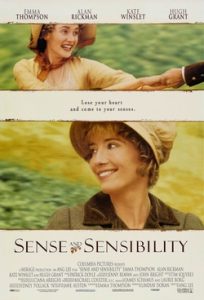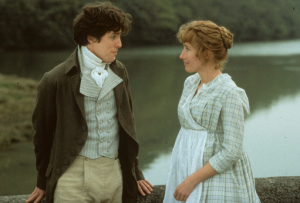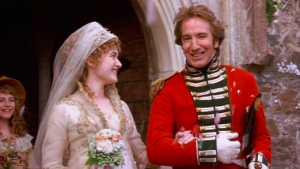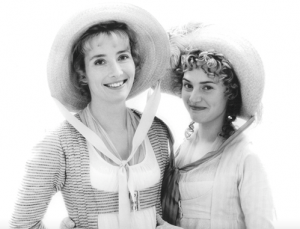Jane Austen’ novel Sense and Sensibility (1811) and its film adaption by director Ang Lee from 1995
“Know your own happiness. You want nothing but patience; or give it a more fascinating name: call it hope.”
In the 1811 novel Sense and Sensibility by the English writer Jane Austen (7775-1817) the relationships between the characters portray the different motives for marriage in the eighteenth century. The film adaptation of Austen’s novel by dirctor Ang Lee, which was produced in 1995, is set in England during the eighteenth century and features the actresses Emma Thompson and Kate Winslet as Elinor and Marianne Dashwood, the protagonists of Austen’s story. The Dashwood sisters and their mother are forced to leave their home after Mr. Dashwood dies and the inheritance goes to his son John. With no dowry, Elinor and Marianne must find husbands who can support them. The film focuses on their journeys that eventually lead to their happy marriages and the men that they encounter along the way. The primary incentives for getting married as shown by the characters are conforming to social norms, financial security, and love.
During the eighteenth and nineteenth century, marriage was an expectation and often a necessity, particularly for less wealthy women who had now large dowry that made them attractive as brides. Throughout Sense and Sensibility, Elinor and Marianne face the pressure to find husbands from their relatives. For example, Mrs. Jennings, who supports the widowed Mrs. Dashwood and her three daughters and offered them an affordable cottage as their new home, tries to play matchmaker for Marianne and Elinor. Mrs. Jennings addresses Marianne and her mother saying, “I declare you are the loveliest girl I ever set eyes on! Cannot you get them married, Mrs. Dashwood? You must not leave it too long!” This remark demonstrates the time constraint placed on marriage for young women. In another instance, John talks to his wife Fanny about his concern for Marianne saying that he fears she “will lose her bloom and end a spinster like Elinor.” John’s remark shows how single women are viewed as less desirable as they get older.
Throughout Sense and Sensibility, the pursuit of marriage is a constant topic of conversation, which inevitably leads to the perspective that any man is a potential suitor for Elinor or Marianne. For instance, when John Willoughby rescues Marianne from the rain, her immediate reaction is that he would be an ideal husband. Although Elinor brings it to Marianne’s attention that she has only just met Willoughby, Marianne expresses a sense of urgency about her feelings for John Willoughby and how perfect he seems. Marianne’s enthusiasm for Willoughby shows her desire to have a relationship with passion and love. The pressure for marriage makes it difficult for women like Elinor and Marianne, who do not have a dowry, to be completely selective about the men they marry. The necessity of getting married often did not mean that women and men married for love in the eighteenth century.
Another motivation for getting married is fueled by greed, which is shown by decisions made by the characters John Willoughby and Lucy Steele. After John Willoughby is cut off from his fortune, he drops Marianne to pursue a woman who is wealthy. Fanny reveals the news that Willoughby is going to “be married at the end of the month—to a Miss Grey with fifty thousand pounds.” Marianne is distraught over Willoughby choosing Miss Grey over herself and tells Elinor, “He would have had a wife he loved but no money—and might soon have learned to rank the demands of his pocket-book far above the demands of his heart.” Willoughby’s decision to marry Miss Grey rather than Marianne demonstrates the importance of having a partner with money in this time period. The other character that exhibits a similar behavior is Lucy Steele, who leaves Edward Farray for his brother Robert after Robert not Edward is given the family fortune. Miss Steele uses marriage to elevate her social and financial standing because she is originally poor. John Willoughby and Lucy Steele’s choices in relationships shows how financial security is a marriage incentive and decisive factor for choosing a spouse.
The different marriage motivations of obligation, financial security, and love can also be interwoven, as portrayed by the relationships between Elinor and Edward Farray and between Marianne and Colonel Brandon. The incentive to marry for love is idealized in Edward Farray and Elinor Dashwood’s relationship. When Edward returns to Elinor after he is at last free from Miss Steele, he tells Elinor, “my heart is and always will be yours.” Elinor expresses her love for Edward throughout the story, so their marriage will be one of mutual and equal affection. Elinor has societal pressure to find a husband, but she has the quintessential situation of finding a man that she also loves. Like the relationship between Elinor and Edward Farray, there is love present in the marriage between Marianne and Colonel Brandon. Colonel Brandon shows immediate attraction to Marianne from the moment he meets her and continually shows his love for her. Although Marianne initially loves John Willoughby, she develops feelings for Brandon towards the end of the story and expresses affection during the scene in which he reads poetry to her. Both Elinor and Marianne face the pressure to marry and secure financial support, but they also are able to find marriages that contain love.
Jane Austen’s story Sense and Sensibility provides a portrayal of the everyday lives of middle and upper-class women during the eighteenth century. As shown by the relationships in the film, women did not have the freedom to marry men solely on the basis of love. Rather, marriage was seen as the determinant for their social and economic status. Marianne and Elinor were fortunate in that they not only received the societal bend fits of marriage, but that they also truly loved their husbands. This ultimately reflects Jane Austen’s own perspective that love should be present within a marriage. Finding “Mr. Right” is for many young women still very important. Today we want marry for love, and love only. But finding Mr. Right is still complicated. That is the reason why the movie by Ang Lee still speaks to us today.
Kate Nicholson, Biology and History, Class of 2019
Sources
Literature and Websites
- “Sense and Sensibility (film).” Wikipedia, at: https://en.wikipedia.org/wiki/Sense_and_Sensibility_(film) (Accessed 20 April 2018)
- “Sense and Sensibility.” Wikipedia, at: https://en.wikipedia.org/wiki/Sense_and_Sensibility_(film) (Accessed 20 April 2018)
- Gay, Penny, “Sense and Sensibility in a Post-Feminist World: Sisterhood is Still Powerful.” In Jane Austen on Screen,ed. Gina and Andrew MacDonald. 90–110. Cambridge: Cambridge University Press, 2003.
- Lee, Ang. Sense and Sensibility. DVD, 1995. Produced by: Columbia Pictures Mirages Enterprises.
Images
- Image 1: Source
- Image 2: Source Photo by Columbia/Tristar – © 1995 Columbia Pictures
- Image 3: Source Photo by Columbia/Tristar – © 1995 Columbia Pictures
- Image 4: Source Photo by Columbia/Tristar – © 1995 Columbia Pictures




